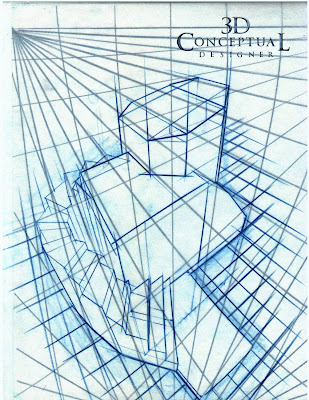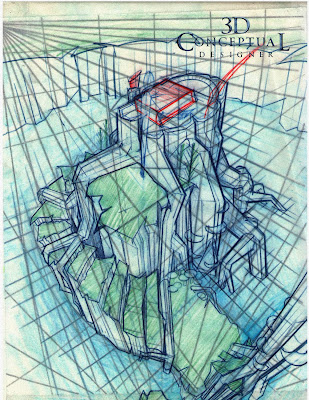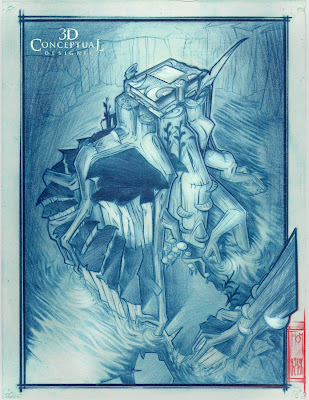 STEP II: This is the blocking model done on velum over the grid.
STEP II: This is the blocking model done on velum over the grid.[ For basic design proportioning using Ship-Curves]
 STEP III: This is the second overlay over the blocked sketch done.
STEP III: This is the second overlay over the blocked sketch done.[Freehand and tighter sketched with Ship-Curves]
 STEP IV: This is the final Artwork done on Velum.
STEP IV: This is the final Artwork done on Velum.[Clear-print Velum,Color-erase Pencil, Indigo Blue Prismacolor and Markers]
Perspective Grid Tutorial
When I design using a traditional 2D approach via hand sketching I use a Perspective Grid as an underlay almost every time.
The reasons are simple; I want to spend my time working out a great design, not spending the time making sure it is drawn accurately in perspective. If you struggle with perspective drawing you spend most of the time adjusting and correcting the way you have drawn a design to make it more accurate to a real world perspective, so if you can minimize perspective mistakes you have freed up your time to focus on the design itself.
The second reason I use a perspective grid is I get a faster blocking of the design early on as I can sketch over a grid with velum or tracing paper taped to the grid I have made and block out an accurate volume in 3D.
I then take the blocking with a grid and do a tight design over the top using freehand and french curve techniques. A great benefit of the grid-underlay is that I can do fish-eye sketches since I can use all curved lines in the view giving it a dynamic view based on an extreme lens.
I save all my grids and have dozens I can reuse with straight lines or curved from almost every conceivable angle.
The reasons are simple; I want to spend my time working out a great design, not spending the time making sure it is drawn accurately in perspective. If you struggle with perspective drawing you spend most of the time adjusting and correcting the way you have drawn a design to make it more accurate to a real world perspective, so if you can minimize perspective mistakes you have freed up your time to focus on the design itself.
The second reason I use a perspective grid is I get a faster blocking of the design early on as I can sketch over a grid with velum or tracing paper taped to the grid I have made and block out an accurate volume in 3D.
I then take the blocking with a grid and do a tight design over the top using freehand and french curve techniques. A great benefit of the grid-underlay is that I can do fish-eye sketches since I can use all curved lines in the view giving it a dynamic view based on an extreme lens.
I save all my grids and have dozens I can reuse with straight lines or curved from almost every conceivable angle.
Cheers, THOM




















No comments:
Post a Comment